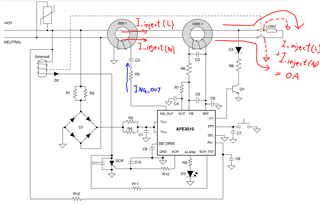Hi Team,
I have a question regarding N-G fault detection, if there is no additional current injected into L, N, then it is difficult to detect N-G fault because the leak current will flow back to N cable from ground.
I am wondering how AFE3010 works to detect N-G fault, when NG_OUT injects a pulse current, transformer's secondary winding will create common-mode reflected current on both N & L cables, then how should current transformer senses differential current under double fault condition(both L and G have leakage path to GND)?

Regards,
Charles

